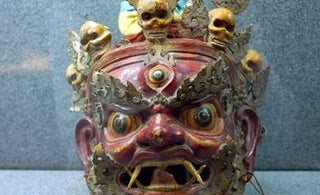
Buddhism, with its profound teachings on suffering and freedom, offers invaluable insights into the human condition. Central to this philosophy is the understanding that suffering is an inherent part of life, and freedom is attainable through enlightenment. In this article, we delve into the depth of Buddhist art, exploring its portrayal of these fundamental concepts.
Understanding the Duality: Suffering and Freedom in Buddhist Art
Suffering, as expressed in Buddhist art, is depicted not only as a human experience but also as a universal truth. At the heart of Buddhist philosophy lies the acknowledgment of suffering as an integral aspect of existence. Through the lens of art, this concept is vividly portrayed. Thangka paintings, intricately woven mandalas, and sculpted representations of enlightened beings illustrate the cycle of existence—birth, aging, illness, death, and rebirth—symbolizing the perpetual nature of human suffering (samsara). The meticulous details and vibrant colors in these art forms mirror the intricacies of life's trials and tribulations, offering viewers a visual narrative that resonates deeply with their experiences.
However, juxtaposed against this depiction of suffering is the portrayal of freedom—freedom from the shackles of suffering and the attainment of enlightenment. Buddhist art transcends the realms of ordinary existence, showcasing serene representations of Buddhas, Bodhisattvas, and celestial beings. These artistic renditions radiate tranquility, embodying the essence of liberation from suffering. The peaceful countenance of these figures, their gentle smiles, and the ethereal glow they emanate symbolize the attainment of nirvana—the ultimate state of freedom and spiritual liberation.
The symbolism embedded within Buddhist art invites contemplation and introspection. Every stroke of the artist's brush, every intricately carved detail, is a testament to the human quest for understanding and transcendence. Each artwork beckons viewers to delve deeper into the profound teachings of Buddhism, urging them to explore the interconnectedness of suffering and freedom.
Moreover, the artistic representation of suffering and freedom in Buddhist art transcends mere aesthetic appreciation. It serves as a visual guide, offering a roadmap to navigate life's challenges and find solace in the pursuit of spiritual growth. Viewers, captivated by these artistic masterpieces, embark on an inner journey—contemplating the transient nature of existence, acknowledging the inevitability of suffering, and seeking the path to liberation.
The artistry inherent in Buddhist creations is not just a portrayal of the human condition; it is a catalyst for transformation. It instills a sense of hope and resilience, guiding individuals on a journey towards enlightenment and the liberation of the soul from the cycle of suffering.
Embracing Buddhist Philosophy through Art Appreciation
These artistic creations are more than mere representations; they are gateways to a deeper understanding of the human condition. Each stroke of the brush, every sculpted form, carries with it the teachings of compassion, impermanence, and the quest for enlightenment. Through vibrant colors, intricate details, and symbolic imagery, Buddhist art invites individuals to embark on an introspective journey.
The depiction of suffering in Buddhist art serves as a poignant reminder of the transient nature of existence. Thangka paintings often portray scenes of human suffering, presenting the cycle of birth, aging, sickness, death, and rebirth (samsara). These vivid representations prompt viewers to contemplate the inevitable aspects of life, fostering a sense of empathy and acceptance towards the universal experience of suffering.
In contrast, the portrayal of freedom in Buddhist art radiates tranquility and serenity. Images of Buddhas, Bodhisattvas, and enlightened beings emanate a sense of peace and liberation. The serene expressions and graceful postures of these divine figures symbolize the attainment of Nirvana—the ultimate freedom from the cycle of suffering.
Art appreciation in the realm of Buddhism extends beyond aesthetics; it becomes a spiritual practice. Engaging with Buddhist art is akin to delving into a vast repository of wisdom and insight. Each artwork becomes a visual scripture, inviting individuals to contemplate the deeper meanings embedded within the symbolism and imagery.
Our Vision: Bridging the Gap Between Art and Enlightenment
Oriental Aesthetics stands as a bridge between artistry and spiritual enlightenment. Our mission is not merely to showcase art but to facilitate a transformative experience. Through guided tours, educational resources, and immersive experiences, we aim to ignite a profound understanding of Buddhist philosophy.
In conclusion, our dedication at Oriental Aesthetics goes beyond the realms of art appreciation; we strive to facilitate a deeper understanding of the purity and brilliance of the timeless and independent aesthetics.























